universe
Latest

Researchers may have detected signals from the universe’s first stars
The early development of our universe is still quite a mystery, but in a new study published today in Nature, researchers describe what may be evidence of when the first stars began to form. After the Big Bang, which took place some 13.7 billion years ago, the universe was dark, hot and full of high-energy particles. Photons couldn't survive, but after around 380,000 years, the universe cooled enough to allow light to actually stick around. That's when the cosmic microwave background (CMB) came to be. It's our universe's first surviving radiation and researchers have looked to it in order to learn more about the earliest years of our universe.
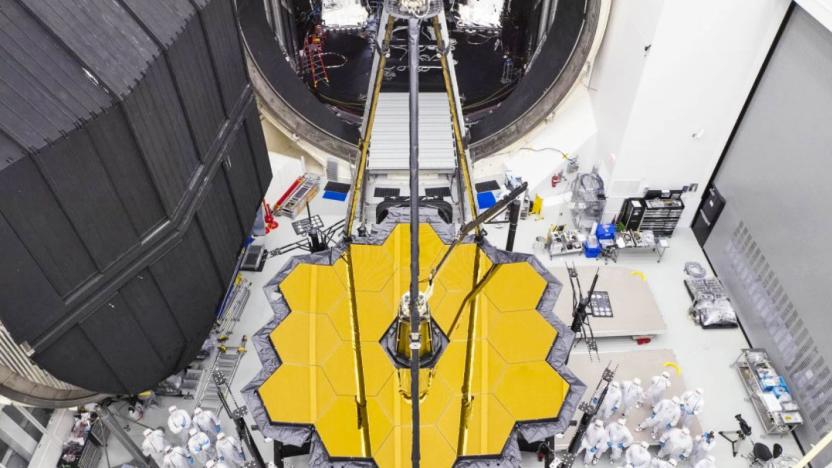
NASA's James Webb telescope is one step closer to launch
NASA's $8.8 billion James Webb Space Telescope (JWST) has just left the thermal vacuum chamber where it's spent more than three months being put through its paces in a series of hardcore cryogenic tests. Scientists wanted to make sure the telescope's instruments and optical element can function properly in the cold, airless conditions of space, and while NASA studies the results, engineers are busy putting JWST back together again, in preparation for its launch in spring 2019.

Astronomers just measured a whole lot more than gravitational waves
A couple of weeks ago, the LIGO (Laser Interferometer Gravitational-Wave Observatory) and Virgo teams announced the detection of another set of gravitational waves -- the fourth since LIGO's first detection in September of 2015. The observations of these ripples in spacetime are extraordinary in and of themselves, no matter how many times we record them. However, while the first three sets of gravitational waves recorded were by the two LIGO observatories, the fourth was also detected by a newly established third -- Virgo -- located in Italy. And having three detectors allows researchers to triangulate the source of those waves with extraordinary precision.
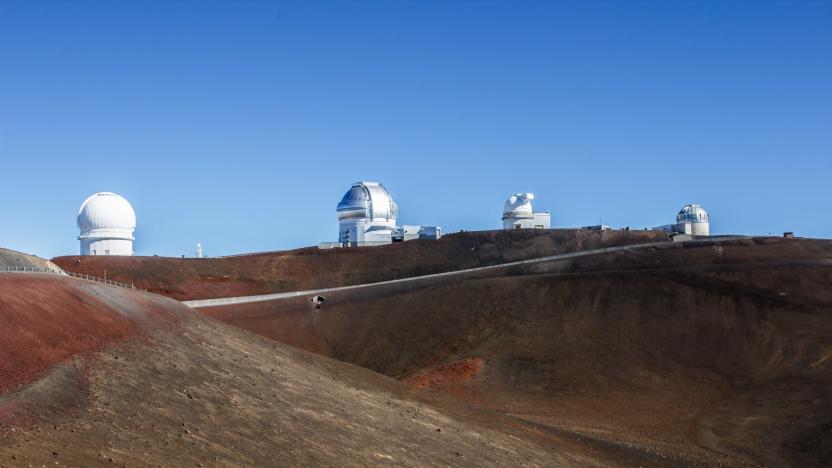
Long-delayed Thirty Meter Telescope gets the go-ahead, for now
Building the world's largest telescope has proven to be even more difficult than one might expect. The Thirty Meter Telescope, which has been planned for construction atop of Hawaii's Mauna Kea, has hit a number of snags, but it got a major approval this week. The state's land board granted the project construction approval in a 5-2 vote, but those that have challenged it from the beginning plan to keep fighting.
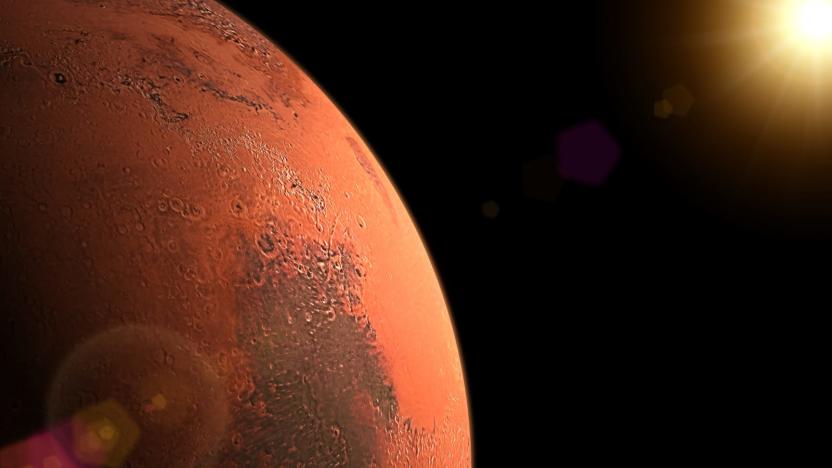
Optical laser uses shockwaves to peer inside distant planets
Scientists at SLAC's National Accelerator Laboratory are able to peer even further into space thanks to an improved optical laser. The laser uses shockwaves to create high pressure conditions in materials, and the material's response is then captured by an ultra-bright X-ray laser, revealing what's going on inside planets and meteors. Upgrades to the optical laser means it's now three times more powerful, with the equivalent power of 17 Teslas discharging their 100 kilowatt-hour batteries in a single second.
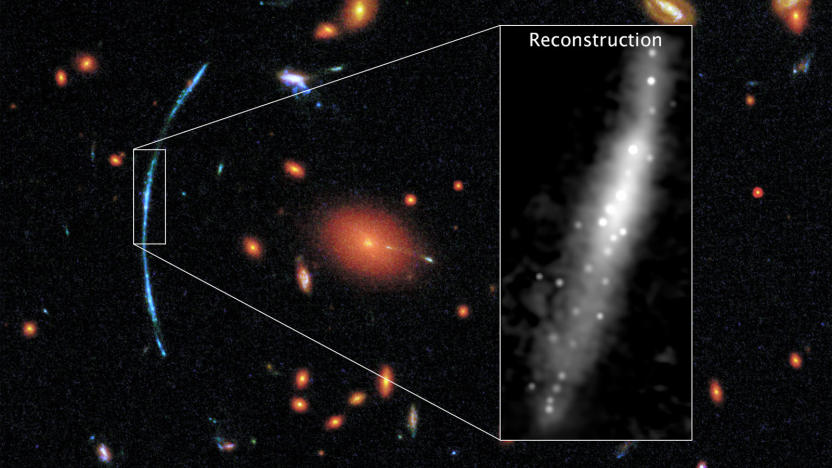
Early universe 'fireworks' challenge notions of how stars form
At the rate things are going, astronomers may have to toss out the rule book for galaxy formation. Researchers using the Hubble Space Telescope have discovered an ancient galaxy (formed 2.7 billion years after the Big Bang) with two dozen star nurseries measuring 'just' 200 to 300 light years across. That sounds big, but scientists had expected that early universe star-forming regions had to be enormous, at 3,000 light years across or larger. Here, they're so tightly packed together that NASA researcher Jane Rigby likens them to "fireworks" popping off at a cosmic scale.
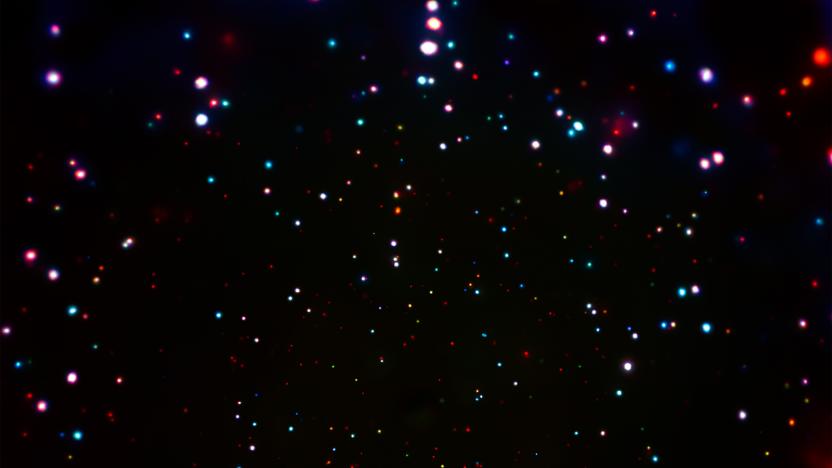
Deepest X-ray image to date uncovers a black hole bonanza
Believe it or not, that's not a star field you're looking at. Researchers have used NASA's Chandra X-ray Observatory to produce an X-ray image of space (the deepest-ever X-ray, in fact) that has uncovered an abundance of supermassive black holes -- they represent 70 percent of the objects in the picture above. Many of these holes would normally be undetectable, especially distant ones from the early universe, and it took 11.5 weeks of total observation time to spot them all. Think of it as a very, very long exposure photo, just for X-ray emissions.
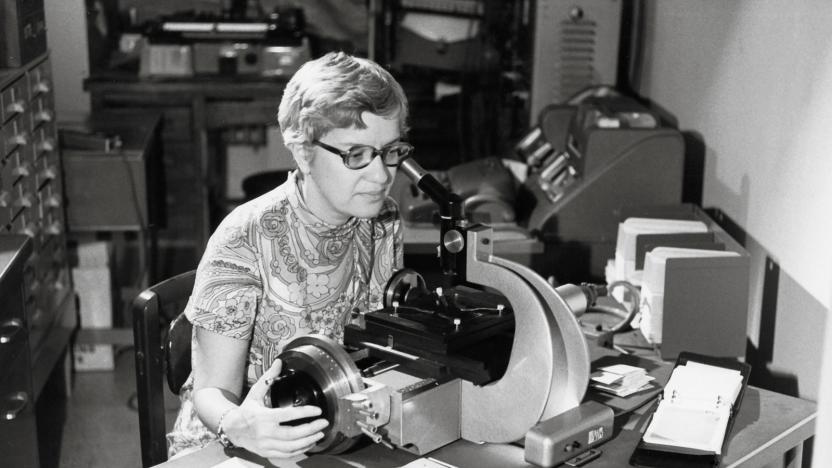
Dark matter scientist Vera Rubin dies at 88
It's a sad time for the astrophysics world. Vera Rubin, who was instrumental to confirming the existence of dark matter, has died of dementia at the age of 88. While the concept of dark matter had been proposed by Fritz Zwicky back in 1933, it was Rubin and her colleague Kent Ford who provided firm evidence in the 1960s and 1970s. They noticed that the stars at the outside of spiral galaxies spin just as quickly as those on the inside -- according to the understanding of gravity at the time, these enormous star formations should tear themselves apart. The only viable explanation was an invisible mass, roughly 10 times larger than what we can see, that was holding everything together.

Google and Elon Musk open their AI platforms to researchers
Artificial intelligence got a big push today as both Google and OpenAI announced plans to open-source their deep learning code. Elon Musk's OpenAI released Universe, a software platform that "lets us train a single [AI] agent on any task a human can complete with a computer." At the same time, Google parent Alphabet is putting its entire DeepMind Lab training environment codebase on GitHub, helping anyone train their own AI systems.
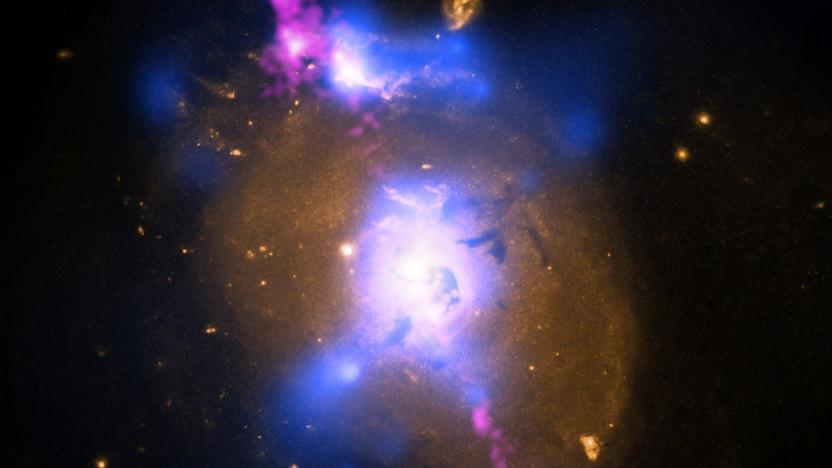
Test can show if the speed of light has changed
Modern science assumes that the speed of light has always been the same. Researchers have suggested that this seeming constant might have changed over time, however, and they now have a way to find out whether or not that's true. Professors João Magueijo and Niayesh Afshordi have developed a prediction that should test for changes in light speed. They've given the fluctuations in density the early universe, detectable through cosmic background radiation, an exact spectral index number based on the theory that light was much faster in the first seconds following the Big Bang (0.96478, if you're curious). If future measurements of the index line up with this number, they'll support the notion that light speed has shifted.

Massive galaxy cluster found 'hiding' behind the Milky Way
You would think that it would be easy to spot a cosmic structure as enormous as a supercluster holding legions of galaxies, but not so -- the Milky Way can hide all kinds of objects, usually due to dust and stars obscuring the view. If you need proof, you just need to ask the astronomers who have discovered the Vela supercluster, a giant collection of galaxies about 800 million light years away (shown as "VSC" above). They only detected it by making "thousands" of spectroscopic studies of partially obscured galaxies -- it was hidden on the far side of the Milky Way.
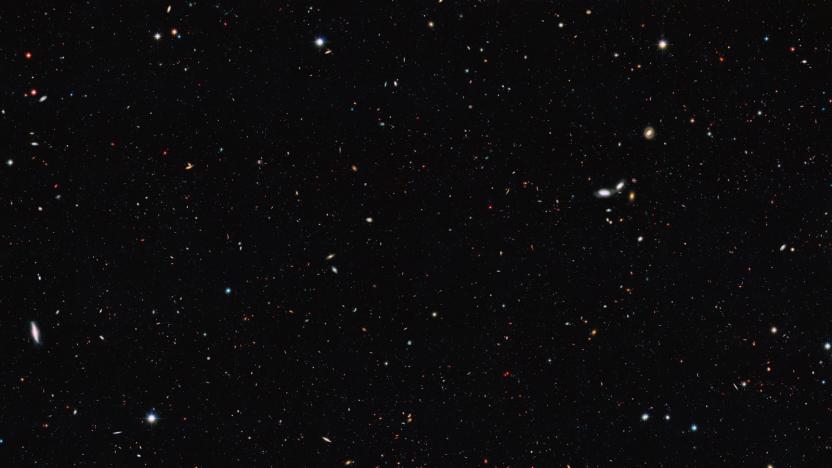
Universe may hold 10 times more galaxies than once thought
The observable universe was already incomprehensibly big, but it now looks to be even bigger. Astronomers have determined that are likely about 10 times more galaxies than previously thought, or between 1 trillion to 2 trillion. We just don't have the technology (or physical proximity) to detect them all, according to the researchers. They reached the conclusion after converting Hubble Deep Field images into 3D to study the number of galaxies at a given point in the universe's history, and using mathematical models to infer the possibility of galaxies that we haven't spotted. Simply speaking, the volume of galaxies seen over time doesn't make sense unless there are many we aren't aware of.

Hubble shows the universe is expanding faster than we thought
New measurements from the Hubble telescope suggest the universe is expanding between five and nine percent faster than scientists initially thought. NASA and the ESA measured the distance to stars in 19 galaxies outside of our own and compared the data to the cosmic microwave measurements taken by the Planck and WMAP probes -- and they didn't tally quite like they should. This potentially puts a question mark above at least a part of science's most enduring tenet -- Einstein's theory of relativity.

Faintest known galaxy could shed light on the early universe
Scientists have only just started finding extremely faint galaxies. However, they've already topped themselves by discovering the faintest known galaxy to date... and it might just provide insight into the universe's early days. Found through gravitational lensing, the galaxy is both supremely ancient (13 billion years old) and extremely tiny (just 0.0001 percent the size of the Milky Way). In other words, it's a textbook example of the dwarf galaxies that researchers believe were key to re-ionizing the universe and taking it out of the lightless "dark ages." With enough study, it could help explain what triggered that ionization and fill in one of the gaps in our understanding of existence.

Otterbox's new case lets you use accessories without removing it
Ah yes, phone cases. A necessary purchase if you're accident prone or tend to drop your handset on the regular. Unfortunately, adding that accessory usually makes for a headaches whenever you try to use another mobile add-on like a thermal camera or lens clip. Typically, you would have to remove your protective case before you could use any of those other gadgets. Well, Otterbox is looking to rid you of that frustration with the new Universe system and it's swappable "accessory modules."

Terrence Malick's universe documentary reaches IMAX October 7th
Director Terrence Malick's movies frequently cover grand concepts (just ask anyone who saw The Tree of Life), but his latest might just top them all. After a long development process, his all-encompassing documentary Voyage of Time will reach IMAX theaters on October 7th. The studio is shy about Voyage's exact contents, but the flick covers time from the "birth of the universe to its final collapse" -- it doesn't get more comprehensive than that. Brad Pitt is narrating the 40-minute IMAX version, while Cate Blanchett will do the same for the as-yet undated 2-hour movie version.
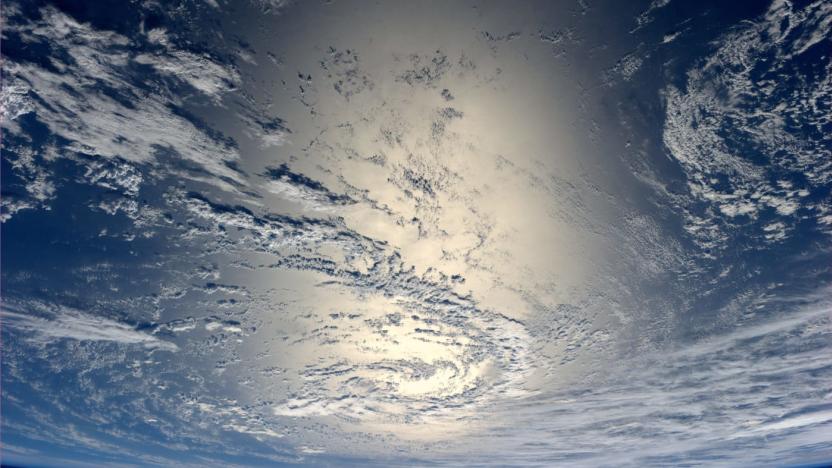
Exoplanet census suggests Earth really is special
There are an estimated 700 million trillion terrestrial planets in the observable universe. Among them, Earth may very well be one of a kind according to a new study from Uppsala University in Sweden. Astronomer Erik Zackrisson and his team have been running computer simulations to model all of the terrestrial planets that are likely to exist in the universe. The probabilistic exoplanetary statistics that they've gleaned from these simulations could potentially upend the Copernican principle and will soon be published in The Astrophysical Journal (it's currently up on arXiv).

The majority of Earth-like planets haven't been born yet
Humanity's inability to find Earth-like planets may not be the result of limited technology or a lack of ambition -- we might simply be too early, and in the wrong place. Astronomers poring over Hubble and Kepler data now believe that only 8 percent of the universe's potentially habitable planets exist. Based on the amount of hydrogen and helium gas left over from the Big Bang, there's still plenty of opportunity for those planets to form. These planets are most likely to appear in either dwarf galaxies or giant galaxy clusters, where the stars haven't used up all the surrounding gas.

Astronomers spot a mid-sized black hole
Black holes typically come in one of two sizes: stellar mass and supermassive. Astronomers believe that there are black holes that fit between these two extremes but finding them has proven difficult, with only a half-dozen candidates currently known. Well, as of today, the tally rises to half-dozen plus one. Scientists at the University of Maryland and NASA's Goddard Space Flight Centre have found another mid-sized black hole, weighing in at 5,000 times the mass of our Sun.

The farthest known galaxy is 13.2 billion years old
Scientists have long reckoned that the first galaxies came into being roughly 500 million to 1 billion years after the Big Bang, but finding these ancient celestial bodies is tricky when their light is so faint that even many specialized tools aren't up to the job. However, researchers have managed to spot a galaxy so old that it's making them question the established timeline for the universe. They've determined that the recently discovered EGS8p7 galaxy is a whopping 13.2 billion years old, making it both the farthest known galaxy to date and just 600 million years younger than the universe as we know it. Theoretically, it shouldn't be possible to see the galaxy at all -- in EGS8p7's era, space was supposed to be full of neutral hydrogen clouds that absorbed radiation and made galaxies invisible to later observers.







